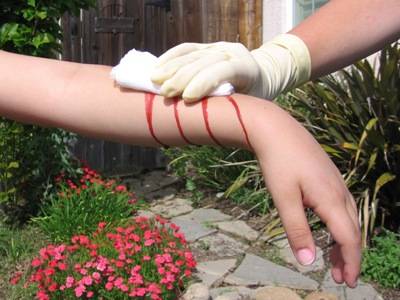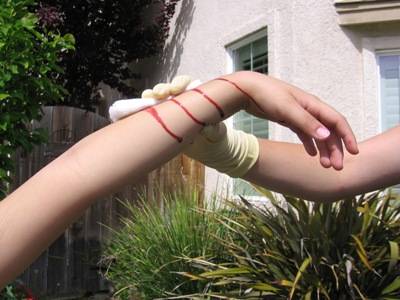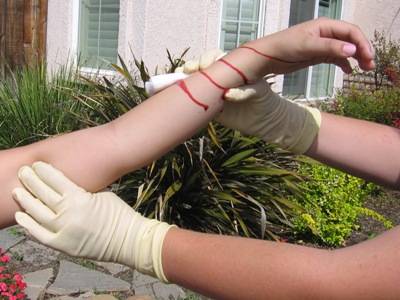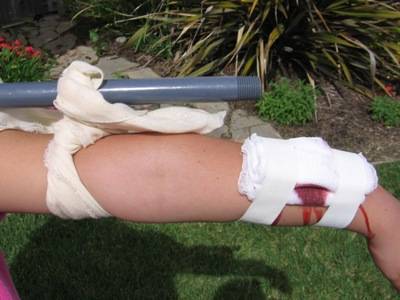|
Bleeding
(Do the following steps if you suspect that there is no broken bones.)

Hold pressure directly on the wound.
Regardless how severe, all bleeding can be controlled. If left uncontrolled,
bleeding may lead to shock or even death. Most bleeding can be stopped before
the ambulance arrives at the scene. While you're performing the steps for
controlling bleeding, you should also be calling for an ambulance to respond.
Bleeding control is only part of the equation.
The first step in controlling a bleeding wound is to plug the hole. Blood needs
to clot in order to start the healing process and stop the bleeding. Just like
ice won't form on the rapids of a river, blood will not coagulate when it's
flowing.
The best way to stop it is to...stop it. Put pressure directly on the wound. If
you have some type of gauze, use it. Gauze pads hold the blood on the wound and
help the components of the blood to stick together, promoting clotting. If you
don't have gauze, terrycloth towels work almost as well.
If the gauze or towel soaks through with blood, add another layer. Never take
off the gauze. Peeling blood soaked gauze off a wound removes vital clotting
agents and encourages bleeding to resume.

Elevate the wound to slow blood flow.
Elevate the wound above the heart. By elevating the wound, you slow the flow of
blood. As the blood slows, it becomes easier to stop it with direct pressure. Remember, it must be above the heart and you must keep direct pressure
on it.

Pressure points should be between the wound and the heart.
Pressure points are areas of the body where blood vessels run close to the
surface. By pressing on these blood vessels, blood flow further away will be
slowed, allowing direct pressure to stop bleeding.
When using pressure points, make sure you are pressing on a point closer to
the heart than the wound. Pressing on a blood vessel further from the heart than
the wound will have no effect on the bleeding.
Common pressure points:
Remember to keep the wound elevated above the heart and keep pressure
directly on the wound.

Tourniquets should almost never be used.
When should you apply a tourniquet? The simple answer: almost never.
Tourniquets severely restrict or occlude blood flow to the arm or leg to
which they are applied. Using a tourniquet to stop bleeding has the
potential to damage the entire arm or leg. Patients have been known to lose
limbs from the use of tourniquets.
Often, if a tourniquet
doesn't cause a loss of function on the extremity which has it, then it probably
wasn't applied correctly. Applying a tourniquet is a desperate move -
only for the most dire emergencies where the choice between life and limb must
be made.
Using a tourniquet
requires wrapping a cravat (non stretchy material like terry cloth or linen)
around an extremity and tightening it with the use of a windlass stuck through
the bandage.
The tourniquet should be
tightened until the wound stops bleeding. If there is any bleeding at the wound
after placing a tourniquet, then the tourniquet must be tightened.
When a tourniquet is
applied, it is important to note the time of application and write that time
down somewhere handy. The best bet is to write the time on the patient's
forehead with a water-proof marker.
-
First Aid Case List -
back to top - |



